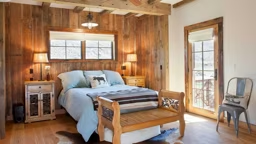
So you’ve built your dream retreat — the last thing you want to do is spend your hard-earned leisure time toiling away at taking care of it. Any home is going to require some degree of upkeep, but with these quick tips, you can keep maintenance to a minimum so you and your home will get the TLC you both deserve.
1. Planning pays off.
Maintenance begins long before there’s even a structure to tend to. When planning the siting for your log or timber home, situate it such that it’s shielded from harsh weather patterns. Be sure the ground slopes away from the home, and the foundation is at least 6 inches above grade to protect it from pooling water.
2. Design with lifestyle and longevity in mind.
Expansive covered porches are practically synonymous with the log and timber home lifestyle. But deep overhangs over outdoor spaces come with the added bonus of protecting your home’s exterior from harsh UV rays, heavy snowfall and intense rain. Designing your porches to be a minimum of 8 feet deep with 2-to 3-foot roof overhangs around the home gives your walls an extra layer of protection. (Meaning less frequent repair and maintenance for you!)
3. Buy better.
For log or hybrid homeowners, a wide variety of stains not only help you achieve your desired aesthetic but can help protect your home for years to come. Whether you choose a stain that’s oil-based, water-based or an emulsion of the two, be sure to buy a product formulated specifically for log homes and/or exposed heavy timbers. Stains for decks or wooden furniture are simply not the same. Stain it right the first time, and you’ll set yourself up for an efficient maintenance schedule for a lifetime.
4. Finishing touches.
When it comes time to landscaping, keep a few key strategies in mind: Plant shrubs at least 3 feet away from the base of the home to allow your exterior materials to breathe and keep moisture and insects away from the walls. (This is also good practice for homes located in wildfire-prone regions.) Keeping a perimeter of roughly 20 feet clear of tall trees also helps prevent twigs and leaves from clogging gutters.
5. Happily ever after.
Finally, one of the simplest steps of all: Take a good look at your home — and not just to admire its striking beauty. About twice a year, ideally in spring and fall, walk the perimeter and look for upward-facing checks, faded stain and breaches in sealants, which could let moisture penetrate the wood fibers. A simple look now could save you time, money and effort in the long run.
Did You Know?
Naturally occurring cracks in wood are called “checks.” They are a normal feature, but upward-facing checks can hold water and lead to longterm damage to your home’s logs.











